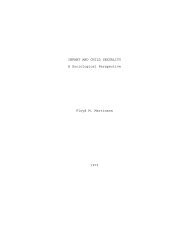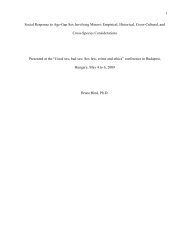Download PDF - Springer
Download PDF - Springer
Download PDF - Springer
You also want an ePaper? Increase the reach of your titles
YUMPU automatically turns print PDFs into web optimized ePapers that Google loves.
Biological Definitions of Pedophilia 337<br />
Apparently, a large percentage of the population has experienced some<br />
form of unwanted sexual abuse. Data on the differential incidence of offending<br />
across perpetrators indicates that a relatively small number of men are<br />
responsible for a large number of offenses. Self-report data gathered from<br />
nonincarcerated pedophiles indicate that some pedophiles are responsible for<br />
a very large number of victims. Reports obtained from 232 child molesters,<br />
who were guaranteed confidentiality, revealed that on average they had victimized<br />
76 children (Abel et al., 1987). Incarcerated pedophiles also report a<br />
high incidence of encounters and, on average, report having 11 more victims<br />
than those for which they were prosecuted (Groth et al., 1982). An accurate<br />
estimate of the number of pedophiles is probably impossible to obtain with<br />
the current data. What can be said is that pedophiles commit many offenses<br />
across a lifetime of offending and are never prosecuted for many of the<br />
offenses that they commit.<br />
NATURE OF THE OFFENDER<br />
A great deal of the existing literature on pedophiles is of an atheoretical<br />
nature. Many of the studies that have attempted to find causal variables in<br />
pedophiles have either not used control groups or have attempted such controls<br />
based solely on the type of offense (e.g., Kopp, 1962). Furthermore,<br />
the existing data are almost exclusively obtained from incarcerated pedophiles,<br />
thus limiting the generalizability of findings. Nonetheless, some valuable information<br />
has been found and should help to illuminate the nature of the<br />
men who seek out children as sexual partners.<br />
In a sample of 34 child molesters incarcerated in Canada, only 26%<br />
had committed their crimes under the influence of drugs or alcohol. Consistent<br />
with current beliefs about the intergenerational effect of abuse, 53 % of this<br />
sample claimed to have been victims of sexual abuse themselves (Earls et al.,<br />
1984). These findings have been replicated in a U.S. sample of 68 pedophiles,<br />
incarcerated in Massachusetts for sexual abuse of children. Of these men,<br />
57% reported having been victims of sexual abuse in childhood. This finding<br />
compared to 23% of 107 rapists in the same institution. Significantly more<br />
child molesters than rapists had siblings with psychiatric histories. Pedophiles<br />
also had more chronic medical problems and lower IQs than rapists (Bard<br />
et al., 1987).<br />
Attempts to make comparisons of the psychological functioning of sexual<br />
offenders based on the age of the victim have revealed some interesting<br />
findings, although the utility of using control groups based upon such comparisons<br />
has been questioned (Quinsey, 1986). Men whose offenses were committed<br />
against children have higher frequencies of avoidant and dependent
















